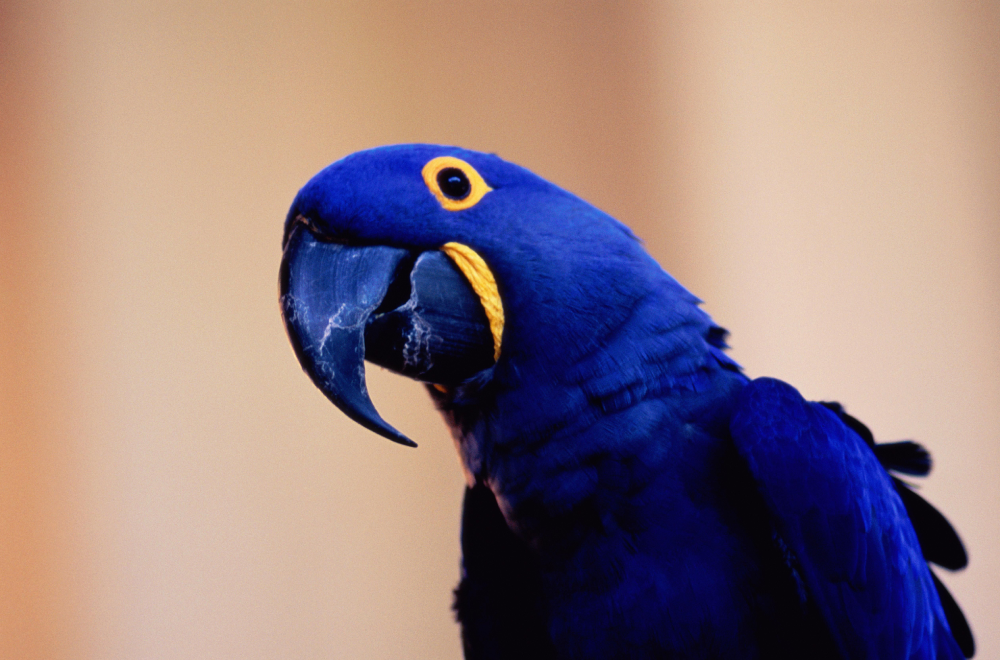In the heart of the lush Amazon rainforest and across the expansive wetlands of South America, the striking figure of the Hyacinth Macaw emerges like a living jewel against the verdant backdrop. Renowned for its vibrant plumage and imposing size, this magnificent bird, scientifically known as Anodorhynchus hyacinthinus, stands as the largest of all parrot species and commands attention with its sheer presence. However, beneath its captivating exterior lies a story of fragility and conservation concern, highlighting the delicate balance between human development and the preservation of biodiversity.
Physical Marvel
The Hyacinth Macaw’s appearance is nothing short of spectacular. With feathers ranging from deep cobalt blue to ultramarine, accentuated by vibrant yellow patches around its eyes and beak, it’s a masterpiece of nature’s palette. Its large, curved beak is a formidable tool, designed for cracking open the hard shells of nuts and seeds, which constitute the bulk of its diet. Standing at over three feet in height and boasting a wingspan of up to four feet, this parrot is a true giant among its avian counterparts.

Habitat and Distribution
The Hyacinth Macaw’s range once stretched across a vast expanse of South America, encompassing parts of Brazil, Bolivia, and Paraguay. Within these regions, it favored habitats such as palm swamps, savannas, and gallery forests, where it could find suitable nesting sites and an abundance of its preferred food sources. However, habitat loss and fragmentation due to deforestation, agriculture, and urbanization have taken a heavy toll on its population, drastically reducing its once expansive range.
Behavior and Social Structure
Despite its imposing size, the Hyacinth Macaw is a social and gregarious species, often forming large flocks that roam the skies in search of food and suitable nesting sites. Within these flocks, individuals communicate through a variety of vocalizations, including loud squawks and screeches that echo through the forest canopy. They form monogamous pairs during the breeding season, with both parents sharing the responsibilities of incubating the eggs and raising the young.
Conservation Challenges
Despite its iconic status, the Hyacinth Macaw faces numerous threats to its survival. Illegal trapping for the pet trade, habitat destruction, and poaching for its feathers have all contributed to a significant decline in its population. Additionally, the extraction of palm trees for commercial purposes has further exacerbated the loss of nesting sites, leaving these magnificent birds increasingly vulnerable to extinction.
Conservation Efforts
Recognizing the urgent need to protect this species, conservation organizations and governmental agencies have implemented various measures aimed at safeguarding the Hyacinth Macaw and its habitat. These efforts include the establishment of protected areas, such as national parks and reserves, where habitat restoration and anti-poaching patrols are carried out to ensure the bird’s continued survival. Furthermore, initiatives aimed at raising awareness among local communities about the importance of conservation have helped garner support for these critical efforts.
Hope for the Future
While the challenges facing the Hyacinth Macaw are daunting, there is still hope for its future. Through concerted conservation actions and sustainable land management practices, it is possible to reverse the tide of habitat destruction and ensure that these magnificent birds continue to grace the skies of South America for generations to come. By working together to protect and preserve their natural habitats, we can ensure that the Hyacinth Macaw remains a symbol of beauty and resilience in a rapidly changing world.









